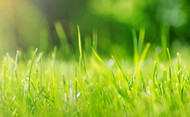Fill your garden with local plants that have evolved over time to thrive in their environment. They will need less care (less water and fertilizer) than exotic plants who cannot adapt to their new surroundings without intensive care and additional resources to promote growth. If you are concerned that local plants may not give you the look that you want, research may change your mind. Many local plants have been pushed to the margins of home gardening and are not well known do to lack of popularity. Do not limit yourself to flowering annuals and ubiquitous trendy succulents--give humble decorative grasses, perennials, shrubs, vines and groundcovers a chance. You can create beautiful gardens with year-round color using only native plants! It's about knowing when they bloom and what light requirements they need. Pictured above, purple coneflowers and black eyed Susans create a complementary purple/yellow display that you can enjoy from summer through the fall. Very little maintenance needed.
Mixing and matching these varieties adds visual impact and helps your garden look full throughout the year. Contact a local garden center, botanical garden, or municipal agricultural office for recommendations. You can also take cues from a walk around your neighborhood in areas where plants are growing without human intervention—the side of the road is a great place to look. And of course, have a look in your own garden and see what plants are struggling and which are threatening to take over. Try moving the strugglers to somewhere else in your garden, or perhaps they don’t belong in your yard at all.



